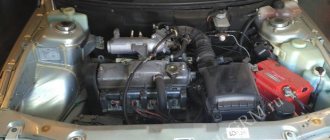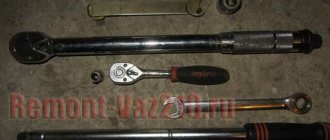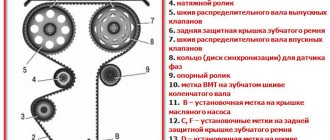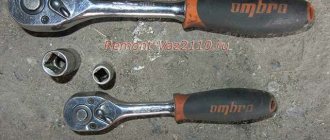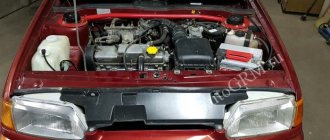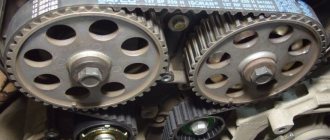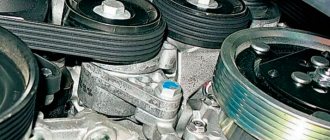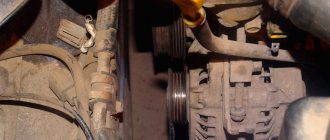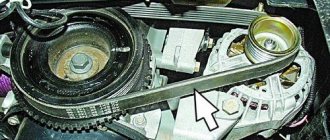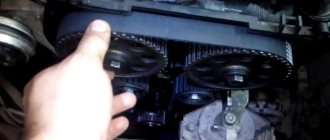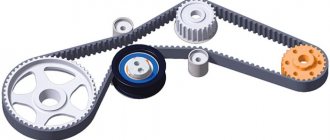How to replace the timing belt of a VAZ-2110 with a VAZ-21124 engine
The timing belt is designed for operation for 60,000 km.
It is necessary to inspect the belt and check its tension at each maintenance. When the tension is weakened, the belt teeth quickly wear out; in addition, the belt may jump on the toothed pulleys of the crankshaft and camshaft, which leads to a violation of the valve timing, loss of power, and engine damage.
The camshafts are driven into rotation from pulley 1 (Fig. 1) of the crankshaft through a belt drive with a toothed belt.
Under the camshaft pulleys there are two rollers: tension rollers 4 on the left, support rollers 9 on the right.
For the support roller, the mounting hole is made in the center of the inner race; for the tension roller, it is located eccentrically (offset from the center by 6 mm).
Therefore, by turning the tension roller relative to the fastening bolt, you can adjust the belt tension.
Camshaft pulleys differ in that a synchronization disk 8 is welded to pulley 7 of the intake camshaft, which ensures the operation of the phase sensor.
The drive is covered with plastic covers at the front and rear.
To set the valve timing, there are timing marks A, D, E on the pulleys, B on the oil pump cover, and C and F on the rear drive belt cover.
When the phases are correctly set, mark A should coincide with mark B, and marks D and E should coincide with marks C and F.
Replace the camshaft drive belt if upon inspection you find:
– traces of oil on any surface of the belt;
– traces of wear on the toothed surface, cracks, undercuts, folds and peeling of fabric from rubber;
– cracks, folds, depressions or bulges on the outer surface of the belt;
– delamination on the end surfaces of the belt.
You will need: the tools necessary to remove the alternator drive belt and the front timing belt cover, a 15-size wrench, a 17-size socket wrench, a special wrench for turning the tension roller or a circlip remover, a mounting spudger or a large screwdriver.
1. Disconnect the wire from the negative terminal of the battery
Overcoming the resistance of the rubber holders, remove the plastic engine cover.
1. Using a 5mm hexagon, unscrew the four screws around the perimeter of the top cover
2. and one screw in the center of the cover.
3. Remove the top cover.
4. Using the same tool, unscrew the two screws securing the bottom cover (the second screw is shown by the arrow)
The best timing belt and rollers for VAZ 2110-12
The timing belt (timing belt), together with the rollers, plays an important role: it ensures the closing and opening of the valves according to the synchronous operation of the piston.
A broken timing belt means stopping the vehicle and towing it to the nearest service station.
How to avoid such unpleasant moments and how to choose a high-quality timing belt ?
What is a timing belt and why is it needed?
This is a rubber closed belt, with notches on the inside, designed to synchronize the crankshaft and camshaft of the engine. What types of timing belts are there? There are two types of timing drive: belt and chain.
The advantage of a belt drive is low noise, ease of installation, no lubrication, small installation space required, low bearing load and the possibility of zigzag installation (camshaft, water pump, oil pump).
The disadvantage is a significantly shorter service life.
If the timing belt is broken:
On cars of the tenth family with 8kL.
The internal combustion engine has no negative consequences (except for the actual replacement of the belt and rollers). At 16kL it bends the valves. How long does it take to change the timing belt?
According to the documentation, on 8kl engines the replacement period is 75t.km, on 16kl engines – 45t.km.
How to replace the timing belt?
Replacing the belt on a VAZ 2110 should be carried out according to the instructions. The timing life greatly depends on the quality of the rollers, so it is recommended to change them along with the belt.
What is the price of a timing belt and rollers for a VAZ?
The cost varies depending on the quality and manufacturer: timing belt from 450 rubles, rollers from 600 rubles.
How to choose the right timing belt and rollers?
Not only the service life, but also the operating noise depends on the quality of the rollers and belt.
To make your choice, you can read reviews on the Internet, or rely on the survey results and article comments.
How to spot a fake?
In order for the rollers to serve for a long time, it is recommended to replace the lubricant:
So, let’s vote and leave reviews about the timing belt and rollers for the VAZ 2110 :
- Which timing belt did you choose?
- How long does it take to change the timing belt?
- Which rollers do you prefer to install?
- Other impressions and comments..
ps All off-topic comments will be deleted.
| Which timing belt is better to choose? | Which timing belt tension roller is better to choose? |
Keywords:
Interesting site? Share with your friends
Source: https://xn--2111-43da1a8c.xn--p1ai/vybor-komplektuyushih/501-vybor-grm.html
Setting timing marks on a 16-valve VAZ-2112 with your own hands
Car : VAZ-2112. Asks : Kostikov Vladimir Igorevich. The essence of the question : I can’t fix the timing marks, how can I set the marks on the timing belt?
I have a problem. When replacing the timing belt, the upper pulleys were not fixed, and now it is not clear how to align them. The marks on the pulleys do not “look” in exactly the same direction. Maybe it would be easier to tighten all the pulleys to the TDC position in cylinder 1? If we are talking about 16 valves, I am familiar with setting the marks on the VAZ-2112: I performed this operation on the timing belt 21124. Well, I have a 1.5 engine. Are there any differences?
Causes of timing belt breakage on a VAZ 2112
Insufficient or excessive tension of the timing belt VAZ 2112 16 valves;- Vehicle operating conditions unacceptable by the manufacturer:
A. Using a car in difficult climatic conditions with increased dust or humidity;
b. Lack of tension control;
- Operation of the drive beyond its service life;
- Contact of lubricating liquids on surfaces not intended for lubrication;
- Water pump malfunction;
- Worn tension and guide rollers.
Set the timing marks correctly - otherwise you will bend the valves!
The VAZ-21124 engine has a special feature: no matter how its pulleys are turned, it does not bend its valves. With the 21120 engine (16 v 1.5 l) such jokes will not work! If the pulley positions are not too far off, try putting on the belt and turning the mechanism to the “TDC 1 and 4” position. From now on, always use the following instructions:
- The crankshaft is set to the required position by checking the mark on the generator drive pulley (photo 1) or on the crankshaft pulley (photo 2);
Alternator drive pulley and crankshaft pulley
Exhaust and intake shaft pulley
In theory, on the VAZ-2112, marking is carried out the same way, no matter what engine we are talking about. Here are photos for engine 21120.
What it looks like in reality and in the instructions
Take the time to find the inspection window on the gearbox housing. There is another mark under the plug.
The last step is optional. And they do it so as not to redo all the work “from scratch.”
- The number of belt teeth between the “upper pulley” marks is exactly 16;
- The mark on the crankshaft pulley sometimes breaks off - use the control method “1” (photo 1) or “3” (lower photo).
Some conclusions
The steel receiver looks powerful and beautiful
All VAZ-2112 hatchback engines differ in characteristics, and the differences are significant. It seems that the best option would be a 16-valve 1.5-liter engine. But the 21124 (1.6) engine has its advantages:
- Rated power is achieved at 5000 rpm rather than 5600;
- A broken timing belt does not lead to bending of the valves and their replacement;
- It is acceptable to use 92nd gasoline.
Any 21124 engine can be converted to Euro-4 or meets these standards immediately.
The appearance of the 1.5 liter engine inspires respect. But if you remember about bending the valves, the choice becomes difficult to make. A steel receiver and a beautiful schedule are not everything.
Various nuances
Motor 21124 is more modern than its brother. It has spark plugs with individual coils installed on it. Experienced craftsmen also know about the tuning possibilities specific to the 21120 engine (for example, installing a turbine). In defense of the latter, we can say the following: the service life of the two engines under consideration is approximately the same. After the first 120 thousand, the 20th engine deserves a rating of “4.5 out of 5”.
On the secondary market, VAZ-21120 and 21126 (Priora) engines are valued almost equally. But the VAZ-21124 unit is in short supply. Draw conclusions.
When is replacement required?
The belt has a resource - a set service life. If this period has expired, the spare part must be replaced even if it looks normal. After all, a break can happen at any moment.
When asked how many kilometers it is necessary to replace the belt so that the belt does not break, experienced car enthusiasts give different answers. Some believe that after 50–60 thousand kilometers. Others clarify: this replacement period is relevant for an 8v (eight-valve) engine. If a 16v (sixteen-valve) engine is installed, then replacement must be done after 30–45 thousand kilometers.
In the video, a practitioner shows what timing belts look like after a long run and whether advertising should be trusted. Filmed by ExpertR channel.
Step-by-step replacement instructions
We will learn how to properly tension the belt and how to set the marks from the video from the channel In Sandro’s Garage.
Tools and materials
To replace a belt on a 16-valve, you will need the following tools:
- fifth key with six sides;
- 10, 15 and 17 mm socket heads;
- ring wrenches or 13 mm open-end wrench;
- extension tube;
- large flat-head screwdriver;
- key for tensioning the belt roller;
- torque wrench.
Replacing the timing belt on a VAZ twelfth model
Algorithm of actions
Installing and tensioning the timing belt on a VAZ 2112 occurs as follows:
- We put the car on a horizontal surface and open the hood.
- We remove the ground terminal from the battery to de-energize the on-board circuit.
- We unscrew the 6 fastening bolts of the belt drive casing to the left of the cylinder head.
- We disconnect the contacts on the crankshaft sensor and check the synchronization of the marks on the camshaft gears with the marks located on the rear surface of the casing.
- There should also be similarities in the marks on the flywheel crown. To check whether it is there, use a screwdriver to unscrew the plug on the crankcase under the thermostat. Above the plug there is a flywheel gear, and on it there is a mark. If the mark aligns with the cut on the crankcase on the left, then everything is in order.
- We adjust the belt tension so as to loosen it and check the crankshaft pulley mark. We remove the belt from the pulley and secure the current position of the flywheel by holding a screwdriver between the crown and the crankcase.
- Use the seventeenth key to remove the generator pulley bolt and check whether there is any similarity between the crankshaft gear with the mark and the mark on the surface of the oil pump.
- We remove the tension roller with the fifteenth key and the support roller; Next we remove the timing belt. We replace the removed rollers and install a new belt.
- Installation begins with the crankshaft pulley. When tensioning the belt, turn the tension roller clockwise, using a special key prepared in advance. You can use pliers with curved ends instead of a wrench. We adjust the tension until it is the best. The best belt tension is when, when grasped with your fingers, it rotates 90 degrees - no more.
- Collecting parts occurs in reverse order. At the last stage, remove the screwdriver clamped in the crankcase. After watching the video from the VAZ 2112 Repair channel, we will learn how to change the belt.
Selecting a new belt
It is necessary to choose the correct size belt. The length of the product should be 742 mm. An important question for car enthusiasts is which manufacturer is better to choose.
Today, high-quality products are produced by both foreign and domestic suppliers:
- Volzhsky Automobile Plant. The factory Lada belt 21126–1006040 is considered extremely durable and reliable and quite competitive in comparison with imported analogues. And for the price it wins.
- Domestic belts BRT "Balakovo". According to experts, they are not inferior to foreign analogues. According to many VAZ owners, they are superior to them.
- Belts from Bosch. The brand is synonymous with product quality. A real Bosch belt performs its intended life without any problems. But brand counterfeits are quite common. The quality of counterfeit products cannot be compared with either Russian or foreign products.
- Gates 5631 xs. These belts are popular due to their durability. There is virtually no risk of breakage during the service life.
- Lynx 137 fl22. The Japanese belt is relatively inexpensive compared to other imported models. But it is also of lower quality and has a smaller resource.
Which timing belt to choose?
| Original manufacturer of spare parts for VAZ 2112 timing belt. They are low cost and designed specifically for Lada cars. Their tolerances, clearances, who else but the plant engineers should know what is best for their car? | |
| Products for VAZ 2112 from the Japanese - Lynx . They have a low service life, although they themselves are of high quality. The Japanese produce spare parts in accordance with the requirements of vehicle maintenance intervals. | |
| Bosch is a well-known manufacturer of tools and spare parts. Only they know what German quality is. Their rubber products are made from wear-resistant, non-toxic materials. | |
| ContiTech is also a manufacturer from Germany. Good quality, but little known. When a car enthusiast buys Bosch products, he also overpays for a well-known brand, but here the company earns its popularity through quality and responsibility. | |
| Optibelt - make products for twelve-valve engines. The products are inexpensive and of high quality, and car enthusiasts install them on sixteen-valve engines. However, it is worth considering that the camshafts have 16 more torque. That is, you just need to monitor the drives more often. | |
| Gates 5631XS . The most popular brand in the domestic spare parts market. The materials are simply good, they last as long as needed. For the VAZ 2112 timing belt, 16 valves are the best option. | |
| BRT is a domestic manufacturer. It makes well-proven products from local raw materials. Don’t think that this is low-quality consumer goods; it is a direct competitor of foreign companies. |
Part numbers for replacing the timing belt
Originals
- 21126-1006040 – timing belt (137 teeth);
- 21126-1006238-00 – automatic tension roller;
- 21126-1006135-00 – guide roller.
Gates produces analogues
- 5631XS – drive belt;
- T43147 – roller with automatic tension;
- KO15631XS – repair kit: belt + roller T43147 + guide roller.
Cover fastening elements
- 21110-1144026-10 – T30 key screw;
- 00001-0011977-73 – spring washer.
VAZ 2112 timing belt replacement is not a complicated operation, it just requires a careful and careful approach. And most importantly - responsibility, because a negligent attitude to tension and condition will lead to major repairs, which will cost a pretty penny.
How to change it yourself?
Before changing the timing belt yourself, you need to study the diagram of the gas distribution mechanism, stock up on the necessary tools, and also imagine the order of work in the form of a sequence of actions.
Before replacing, study the timing diagram
There are differences between modifications of the VAZ 2112, but the basic algorithm is approximately the same for all modifications. This algorithm can also be used on VAZ cars of other modifications, for example, 2110. It is necessary to have a good manual that explains the progress of work step by step. And if you have at least a little experience in car maintenance and minor repairs, we can calmly carry out timing belt maintenance ourselves and change the necessary parts.
Tools and materials
The set of basic tools is small:
- socket heads for 10, 15 and 17;
- spanner or open-end wrench 17;
- large flat screwdriver;
- key for the tensioner pulley (if power steering is installed on the car).
The materials required are a new timing belt.
Step-by-step instruction
- The work begins by removing the negative terminal of the battery.
- Using a 10mm socket, unscrew the six bolts and remove the gas distribution mechanism cover.
- The crankshaft sensor chip is disconnected.
- The crankshaft sensor mount is unscrewed. Then you need to remove the sensor.
- The sensor hole must be aligned with the part of the pulley where there are no teeth. This is done so that the crankshaft sensor can detect TDC (top dead center). In addition, the area without teeth is used to block the pulley. After alignment, you need to put a 12mm hexagon in the hole of the sensor and fix the pulley.
- When the pulley is blocked, the generator nut is unscrewed.
- The belt tension roller bolt is loosened. After this, the belt is removed. Often during this operation the tension and support rollers and the pump are also changed.
- Installing a new timing belt. There are two ways to correctly install this part. First: put on the belt with the tension roller removed. The tension is adjusted after installing the roller. Second: install the belt by turning the exhaust camshaft pulley using a 17mm wrench.
- Next, you need to tighten the timing belt using the adjusting bolt. It rotates using a 10 key. Rotation clockwise increases the tension, counter-clockwise weakens it.
Malfunctions and repairs
The most common malfunction that VAZ 2110 owners encounter is when the 21124 engine fails. This is expressed in unstable engine operation, interruptions in operation, increased vibration, noise and gasoline consumption. What could be the reasons for this unpleasant phenomenon and what repairs will be required on the VAZ 21124 engine.
If the engine in any VAZ 2110 car is malfunctioning, then, firstly, you need to find out the reason, diagnose the ignition, fuel supply system, gas distribution mechanism, electronics and mechanical parts (pistons and crankshaft) and repair the VAZ 124, even if you do it yourself .
- Ignition - the wires are removed from the spark plugs one by one. If the friction increases when the wire is disconnected, then the cylinder is working. If it still troits, that means the problem lies there. In this case, the spark plug and high-voltage wire are checked. The easiest way is to install new ones, and if the problem is not solved, then the diagnosis must be continued by checking the ignition module. You can also try to replace it with a working one, or test its circuit with a multimeter.
- The cause of interruptions may be poor quality fuel. In this case, you need to change it and also wash the injectors.
- The piston and valve groups are tested together. First, you can disconnect the breather hose. If white smoke comes from the breather, then the problem is hidden in the pistons, or rather in their rings. If there is no smoke, then it is necessary to measure the compression. Reduced compression usually indicates a valve failure. If compression is normal, you can try adjusting the valves. Engine malfunctions can occur due to clamped or, conversely, too loose valves. These cases threaten to carry out the most complex and expensive repairs of the VAZ 21124.
- Interruptions can also occur due to a faulty crankshaft position sensor. It is removed, marking its position, and the resistance of the sensor coil is checked. Normally, it should show a resistance of 550-750 Ohms.
The 124 engine does not cause any other special problems. Previously, there was a problem with the impact of the valves on the piston and bending of the valves and the subsequent need to repair VAZ of previous modifications. But the 124th engine is freed from this problem due to recesses in the piston bottoms.
Price issue
In the case of replacing one timing belt yourself, the cost of repair is determined only by the price of the belt. This is from 630–650 rubles. Rollers cost about the same, so a repair kit consisting of a belt and two rollers can be purchased for about 2 thousand rubles. If you decide to also replace the pump, then another 1200–1300 rubles are added to this figure.
Compared to work at a car service center, replacing one belt yourself will save about 1,500 rubles, and replacing a belt and rollers will save about 3 thousand rubles.
VAZ 16-valve engines: video comparison
The GATES K055468XS timing kit includes a reinforced timing belt and two pulleys in a metal housing, a tensioner and a support. Designed for installation on 16-valve VAZ 2112 and 21124 engines, which were installed mainly on VAZ cars of the “tenth” family.
GATES belts with the letters XS in the marking have improved characteristics that significantly exceed the requirements of the car manufacturer. First of all, this relates to increased tensile strength, as well as a wider temperature range of operation.
The high reliability of both the belt itself and the rollers from the GATES K055468XS set primarily attracts owners of the so-called “plug-in” VAZ 2112 1.5-liter engines. In addition, such kits are often used when boosting engines, because They cope well with increasing loads.
Source
Consequences of untimely shift
If the timing belt is not changed in a timely manner, it may break. While driving on the highway, this can lead to an accident. If the accident was avoided, you will have to spend money on a tow truck to deliver the car to the repair site. If the belt breaks, the movement of the camshafts and valves will stop, but the movement of the crankshaft will continue, which may result in damage to the valves as a result of the impact of the pistons. Repair may be limited to replacing the timing belt and rollers. But only if an 8 valve engine or 16v 1600 cc is installed. cm, that is, safe from the point of view of bending the valves (21114, 21124 or simply 124).
If the valves are bent, a major overhaul of the engine will be required, which will cost from 20–30 thousand rubles. In some cases, it will be cheaper to purchase a new engine, although this will lead to other problems - registration. Based on the above, it is much easier, safer and cheaper to change an inexpensive part on time.
Graphs of 16 valve engines - power and torque
All engines of the “tenth hatchbacks” are ordered by power as follows: 21120, 21124, 21114 and 2111. They develop 93, 90, 81 and 77 “forces”. The graph shows how power varies with rpm.
The first two engines, 20 and 124, are 16-valve. Both belong to the Euro-3 class.
Engines 21124 of later years of production meet Euro-4 standards. They have an improved catalyst installed. The ECU unit was also installed differently, updated.
124 engine under the hood of the “two-wheeler”
The pistons of the 124 series engines have grooves for the valves. Simply put, the internal combustion engine of the VAZ-21120 is plug-in (valve bending as a result of a broken timing belt, the valves will need to be replaced, and then it depends), and 21124 is not plug-in (does not bend the valve). Let's estimate the torque.
The most interesting thing here is the VAZ-21120 engine. In terms of “low-end traction” it is not much inferior to 8-valve engines.
Formal characteristics
Here are the characteristics of two different motors:
- ICE model: 21120/21124;
- Working volume: 1,488/1,596 l;
- Compression ratio: 10.5/10.3;
- Power: 93/90 hp;
- Rated power speed: 5600/5000 rpm;
- Maximum torque: 140/131 N*m;
- Recommended fuel: AI-95/AI-95;
- Ecology: Euro-3/Euro-4 or Euro-3.
The lower the compression ratio, the more “omnivorous” the engine will be in relation to fuel.
Timing marks - installation of timing marks using the example of a VAZ 2110, 2111 and 2112 engine
Dear friends, today we will tell you the basics of setting timing marks using the example of a VAZ 16 valve engine. It's no secret that correctly set timing marks are the key to proper engine operation. If the marks are set incorrectly, then normal engine operation is impossible. It is also important to tension the belt correctly, this greatly affects its durability. So, when do we have to deal with the procedure for setting timing marks? When, according to the regulations, we need to replace the timing belt at the next maintenance, by the way, the rollers are also necessarily changed along with the belt in this case. Also, if our pump is “covered,” the timing belt will have to be removed, since it is this that drives our “water pump.” Well, what if (the worst case scenario) is that our belt broke. Here, if the engine is “plug-in”, then this is a huge nuisance, the pistons meet the valves, and at a minimum, we are guaranteed to remove the cylinder head and replace the valves. So, what are timing marks and where are they applied? The first is the marks on the camshaft pulleys, both on the intake and exhaust:
They must coincide with the mark on the crankshaft, and there are already several methods for calculating this mark. It’s quite difficult to remove the generator belt pulley (it doesn’t allow you to see the mark) and see if the marks match.
With such a coincidence of the piston marks, they are at TDC (Top Dead Center)
The second method is to calculate the DPKV sprocket by the teeth
Belt replacement
Replacing the timing belt must be described separately, depending on how many valves your VAZ 2110 has - 8 or 16. Self-repair of the unit on an 8-valve engine is considered easier, although you should not have any serious problems with a 16-valve engine.
8 valve
The sequence of work will be as follows:
Disconnect the battery by removing the negative cable; Unscrew the bolts from the belt protective cover; Remove this protective cover; Remove the front wheel on the passenger side, while simultaneously removing the mudguards and engine compartment protection; Turn the generator pulley clockwise so that the marks on the cover and the pulley match; Remove the protective plug from the gearbox and check in the resulting hole to see how much the control marks match; Using a metal screwdriver or other object, you need to block the flywheel; After this, you can unscrew and remove the generator pulley; Make a few turns to loosen the nut that holds your belt tensioner pulley in place; Remove the old belt. You won’t need it anymore, so feel free to send it to the landfill; The space needs to be cleaned and degreased. White spirit is perfect for this; After rinsing, dry everything using a dry and clean cloth; Install a new roller, following the direction arrows
If they are missing, then take the inscription into account. It should be located from left to right, that is, you could read it without any problems; To tighten the belt, move the roller counterclockwise; Check that all marks and the degree of belt tension match correctly; The compression ratio should be checked on a cold engine and at an air temperature within 15-30 degrees Celsius; Turn on the motor and with the unit running, check whether you have installed everything correctly; If the sound is normal, then the installation was completed correctly; Reassemble the removed elements in reverse order.
Description of the procedure for replacing the timing belt VAZ 2110, (2112) 16 valves
Former flagship of the Russian automobile industry VAZ 2110 with a 1.5 16 valve engine. Scheduled replacement of the timing belt 30,000 km after the last replacement. The autopsy showed that if they had not changed it today, then tomorrow there would have been more work for our mechanic. In general, we recommend that all customers check the condition of the belt at least once every 5,000, or once a year. But knowing the quality of our spare parts, more often is better. On this engine, if the belt breaks, almost all the valves bend. The article is also relevant for VAZ 2112))
We look, remember and don’t let it get to that point.
The patient became five millimeters narrower and generally looked very bad. We send him to the honor board.
And here is the hero of the occasion himself.
We remove the absorber and power steering reservoir so that they do not interfere in the future.
We loosen the bolt by seventeen, the tension roller of the service belt and remove the last one. It will not be possible to remove it completely because the engine mount is in the way. If the belt requires replacement, you will have to unscrew the engine mount.
Remove the tension roller. We unscrew the bolts securing the upper protective cover; they are hexagonal.
Remove the right wheel, plastic mudguard and drain the antifreeze.
We see the crankshaft pulley. Using its bolt, clockwise, rotate the crankshaft until the marks on the camshaft pulleys and the timing belt protective cover match.
Markings on the left exhaust camshaft. The mark on the protective cover is highlighted in red.
Likewise for the intake camshaft. He's on the right. Its pulley has an inner ring for the phase sensor, so it is very difficult to mix up the pulleys.
Remove the crankshaft pulley. Let's lock the crankshaft with the help of a friend. We put him in the car and force him to turn on fifth gear and press the brake all the way. And at this time, with a slight movement of your hand, unscrew the crankshaft pulley bolt. Remove it and the lower protective cover.
We see that the mark on the sprockets and the slot on the ebb of the crankshaft cover coincide.
Loosen the seventeen bolts of the tension and idler pulleys and remove the timing belt. Then the videos themselves. We change them anyway.
We lock and unscrew the camshaft pulleys and remove them. Remember that the right camshaft has a pulley with an inner ring for the phase sensor. The picture should look like this.
We unscrew everything that holds the protective plastic cover and remove the latter. Unscrew the three bolts holding the pump. They are hexagonal.
The pump for a sixteen valve engine is slightly different from the usual for an eight valve engine. It has a small threaded ear for attaching the protective casing.
Lubricate the gasket with a thin layer of sealant and put the pump in place. Tighten the fastening bolts. We put the protective cover in place. We make sure that he sits in his place, otherwise he will rub the belt. If everything is in order, tighten everything that holds it and install the camshaft pulleys and new rollers.
We check that the marks on the camshafts and crankshaft match. We install a new timing belt. If there are no directional arrows, put it so that the inscription is read from left to right.
The right, or descending, branch of the belt should be tight. You can turn the right camshaft clockwise a few degrees, put on the belt and turn it back. In this way we will stretch the descending branch. The tension roller has two holes for a special key. You can find it in any auto store. The issue price is 60 rubles. To tension the timing belt, insert a special key and counterclockwise . Since there is a lot of controversy about tensioning the timing belt, we will write this: a tensioned belt should not have a sag between the camshafts of more than 5 mm when pressed and 7 mm on the longest branch (specially experimented). Remember: an overtightened belt reduces the service life of the pump, and an undertightened belt can lead to cylinder head repair. (photo below)
We check all the marks. We turn the crankshaft two turns and check the marks again. If the pistons and valves do not meet and the marks coincide, then accept my congratulations. Then we put everything back in place in the reverse order of removal. Don't forget to tighten the bolts. We tighten the service belt roller with the same wrench as the timing belt tension roller. Fill with antifreeze and start the car. We wish the belt many years of service, but don’t forget to check it periodically; after all, it was made in Russia.
But what happens when the belt breaks on a 1.5 16 valve engine.
Now you can easily change the timing belt on a sixteen-valve engine, your favorite ten.
Design features
The main part of the engine, the cylinder block (catalog number 11193-1002011), also differs in size from its predecessor. It is factory painted blue. Its height, the distance from the crankshaft axis to the upper plane, became 197.1 mm, versus 194.8 mm on the 2112 model.
The dimensions of the holes for the block head mounting bolts have changed; they are from the hoist with M10×1.25 threads. The main bearing supports on the 124th engine, from the second to the fifth, are equipped with channels designed to supply oil that cools the piston during operation.
The crankshaft installed is the same as on models 21126 and 11194, with the marking 11183 cast on the sixth counterweight. Due to the crank radius of 37.8 mm, a piston stroke of 75.6 mm was provided. A toothed pulley is installed on the shaft for timing belt drive. The belt is 25.4 mm wide and has 136 teeth, parabolic in shape. Belt service life is 45,000 km.
The pulley is designed to drive additional units using a V-belt. Three types of belts are used, differing in length, depending on the equipment:
- If the drive is only for the generator, the belt length is 742 mm.
- With power steering - 1115 mm.
- With power steering and air conditioning 1125 mm.
The pulley is designed in such a way that it acts as a damper, reducing the torque loads acting on the shaft. Another function is to determine the position of the crankshaft using a sensor and a gear mounted in the damper.
The improvement affected the pistons. Their bottoms are made with valve recesses 5.53 mm deep to avoid the valves hitting the piston bottom when the timing belt breaks.
On previous VAZ 16v models without recesses or with recesses of shallower depth, in such a situation there was a risk of bending the valves, which led to expensive repairs. So, concerns and frequently arising questions about whether the valves bend on this engine have been removed.
Oil scraper and compression rings are made of steel or cast iron. The pistons and connecting rods are connected using floating pins, 22 mm in diameter, 60.5 mm in length, secured with retaining rings. The pins and connecting rods are borrowed from the VAZ 2110 modification.
The block head for the 16 valve LADA 21124 engine has an enlarged docking area for the intake manifold flange. Both camshafts for the exhaust and intake valves, as well as the valves themselves, springs, and hydraulic compensators have also been preserved from the previous modification of the engine.
In order to avoid confusion, the shafts are marked with a digital code. If it ends at 14, then this is the exhaust valve shaft, if at 15, then this is the intake shaft.
Another difference is that there is a raw strip on the intake shaft, next to the first pushrod. By adding hydraulic compensators to the design, the manufacturer eliminated the need to maintain valves in terms of adjustment. But, they are very sensitive to the cleanliness and quality of the lubricant. Low-quality oil will quickly damage parts and must be replaced; such repairs are not provided for the VAZ 124.
The spring-valve group is similar to model 2112. Valves with one spring and rods with a diameter of 7 mm (on eight-valve heads their diameter is 8 mm). Toothed pulleys with marks for setting the valve timing are installed on the camshafts. Compared to model 2112, the marks are shifted relative to each other by 2°.
Just like the shafts, the pulleys have differences in design and markings - on the inlet, a strip is welded on the back side, on the outlet it is missing. Both pulleys have markings in the form of circles on the hub.
Correct belt tension is done using support and tension rollers with flanges (to eliminate the possibility of slipping).
The cylinder head gasket is made from asbestos-free material. The holes for the cylinders are made with metal edging.
The intake manifold is combined with the receiver and is made of plastic.
For the first time in cars of the VAZ 2110 family, a catalytic converter was installed, combined with an exhaust manifold. Depending on what EURO 4 or 5 requirements the 124 motor is designed for, a different type of collector is installed.
Engine tuning 21124
There is no point in considering chip tuning of a 124 engine, it will not make any noticeable changes on a standard car, the firmware is needed for more thorough and correct tuning, after the engine has been modified, we will start with it. The simplest and most standard way to increase the power of the 21124 engine is to replace the camshafts with Stolnikov 8.9 280 or Nuzhdin 8.85, install a 4-2-1 direct-flow exhaust, a receiver and a 54-56 mm damper, this will give us a total of more than 120 hp, and for more efficient operation of the motor, we replace the piston with a lightweight Prior one. This will further increase power and reduce fuel consumption. If these numbers are not enough, it is recommended to modify the cylinder head and install wide-phase shafts, which will give an output of 150+ hp.
Compressor for VAZ 21124 16V
As an alternative, and also to obtain similar power over the entire range, you need to install a compressor. The most common compressor for VAZ is the St. Petersburg kit based on the PC-23, but the Internet is full of videos on compressors both on the 8 valve and on the shesnar, in one of the most famous videos, the owner of the motor on the compressor clearly explains all the nuances of installation and what is required for the successful implementation of the project using the example of an eight-valve engine. This compressor can also be installed on a 16 valve engine.
Attention MAT (18+)
It is possible to increase power without using a turbine up to 200+ hp, using a 4-throttle intake, but the most optimal options suitable for urban use are the methods described above.
4 throttle intake for VAZ 21124
To increase the stability of the engine and the response of the gas pedal, install 4 throttles. The bottom line is that each cylinder receives its own throttle valve and, thanks to this, resonant air vibrations between the cylinders disappear. We have more stable engine operation from bottom to top. The most popular method is to install a 4-throttle intake from Toyota Levin on a VAZ. You need to purchase: the unit itself, make an adapter manifold and pipes, in addition to this you need a nulevik filter, injectors, MAP (absolute pressure sensor), fuel pressure regulator and firmware. There are also ready-made 4-throttle intake kits on sale that are quite suitable for use. Considering the prohibitive speeds, it is recommended to replace the heavy piston 124 engine with a lightweight Priora one, wide-phase shafts (at least 280), a modified cylinder head, a 4-2-1 spider exhaust with 51 pipes or more. For more complete information on throttles, see the article on tuning the 2112 engine. With the correct configuration, the 124 engine produces about 180-200 hp. The disadvantages include a reduction in engine life, and this is not surprising, because the engines on the pipes spin at more than 8000-9000 or more rpm. So you cannot avoid constant breakdowns and repairs.
Turbine for VAZ 21124
Inflating your engine is probably the dream of any owner of a car with a 124 engine, but how to do it correctly and how to then drive it is described HERE, at the very bottom, all these principles are applicable on a 124 engine.
Replacing the timing belt VAZ 2112 1.6 16 cl.
1. Remove the timing belt protection. The timing belt guard is secured with six bolts. Remove the chip from the crankshaft sensor, unscrew one bolt and remove the sensor.
2. One tooth is missing on the pulley, this is not without reason, this allows the crankshaft sensor to determine the top dead center, and also allows you to block the crankshaft in order to unscrew and tighten the pulley mounting bolt.
3. This is done like this: the pulley is aligned with the hole for the crankshaft sensor and through the hole for the sensor, a suitable size tube or other suitable object is inserted, in my case it is a hexagon, the pulley is blocked, and then unscrewed and removed.
4. Loosen the tension roller nut and remove the old timing belt.
5. Install a new belt, the belt can be installed by turning the right camshaft with a wrench, or you can remove the tension roller, whichever is more convenient for you.
6. Tighten the pulley mounting bolt back and align the timing belt drive gear according to the marks. If there are no marks on the oil pump housing, put marks on the flywheel and, using a chisel, make a mark on the oil pump, this will be more convenient.
7. Align the marks of the camshaft pulleys so that the timing belt drive gear does not go astray
8. Using a special wrench, tighten the belt with a tension roller. If there is no key, don’t be upset, you can tighten it with two nails and a screwdriver between them, or you can take a steel fork, remove the two middle teeth completely, and shorten the two outer ones in half and bend them. Be sure to remember to tighten the tension pulley nut. (To tighten the belt, turn the tension roller counterclockwise (about 10–15°); to loosen it, turn it clockwise)
9. Turn the crankshaft two full turns and check the marks; if all three marks match, put the pulley in place, do not forget about the generator belt and crankshaft sensor, then the belt protection and you can start the engine.
Timing belt tension
1. Check the belt tension. A correctly tensioned belt should rotate 90° from finger force (1.5–2 kgf) in the middle between the crankshaft and camshaft pulleys.
2. I take it with two fingers between the camshafts and up and down. 5-6 mm fluctuates back and forth, then I leave it.
3. Adjust the timing belt tension using a special device. The most correct belt tension is 2 kGs. Having achieved this result, fasten the fastening nut.
Engine characteristics 21124
Years of production – (2004 – today) Cylinder block material – cast iron Power system – injector Type – in-line Number of cylinders – 4 Valves per cylinder – 4 Piston stroke – 75.6mm Cylinder diameter – 82mm Compression ratio – 10.3 Engine displacement VAZ 21124 – 1599 cm3 Engine power 21124 – 89 hp. /5000 rpm Torque - 131 Nm / 3700 rpm Fuel - AI95 Fuel consumption - city 8.9 l. | track 6.4 l. | mixed 7.5 l/100 km Oil consumption - 50 g/1000 km Engine 21124 oil: 5W-30 5W-40 10W-40 15W40 How much oil is in the VAZ 21124 engine: 3.5 l. When replacing, pour 3.2 liters.
Engine life 21124: 1. According to the plant - 150 thousand km 2. In practice - 200-250 thousand km
TUNING Potential – 400+ hp. Without loss of resource - up to 120 hp.
